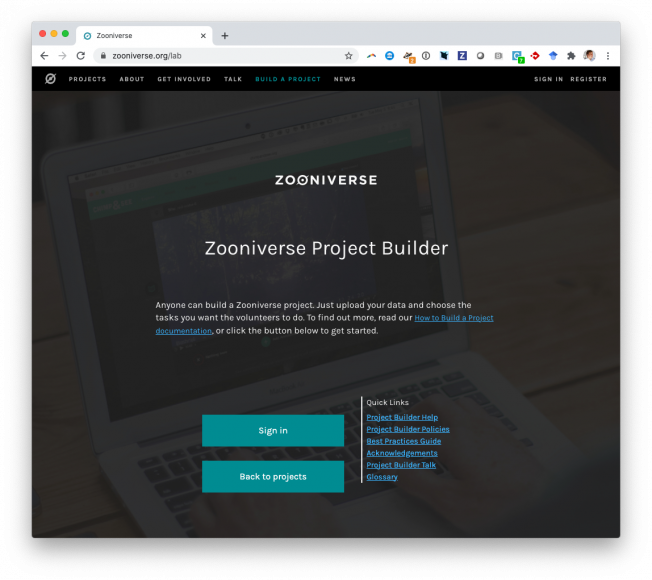Galaxy Zoo: Dust in Spirals
ArXiv 1001.1744 (2010)
Abstract:
We investigate the effect of dust on spiral galaxies by measuring the inclination-dependence of optical colours for 24,276 well-resolved SDSS galaxies visually classified in Galaxy Zoo. We find clear trends of reddening with inclination which imply a total extinction from face-on to edge-on of 0.7, 0.6, 0.5 and 0.4 magnitudes for the ugri passbands. We split the sample into "bulgy" (early-type) and "disky" (late-type) spirals using the SDSS fracdeV (or f_DeV) parameter and show that the average face-on colour of "bulgy" spirals is redder than the average edge-on colour of "disky" spirals. This shows that the observed optical colour of a spiral galaxy is determined almost equally by the spiral type (via the bulge-disk ratio and stellar populations), and reddening due to dust. We find that both luminosity and spiral type affect the total amount of extinction, with "disky" spirals at M_r ~ -21.5 mags having the most reddening. This decrease of reddening for the most luminous spirals has not been observed before and may be related to their lower levels of recent star formation. We compare our results with the latest dust attenuation models of Tuffs et al. We find that the model reproduces the observed trends reasonably well but overpredicts the amount of u-band attenuation in edge-on galaxies. We end by discussing the effects of dust on large galaxy surveys and emphasize that these effects will become important as we push to higher precision measurements of galaxy properties and their clustering.Galaxy Zoo: Dust in spiral galaxies
Monthly Notices of the Royal Astronomical Society 404:2 (2010) 792-810
Abstract:
We investigate the effect of dust on spiral galaxies by measuring the inclination dependence of optical colours for 24 276 well-resolved Sloan Digital Sky Survey (SDSS) galaxies visually classified via the Galaxy Zoo project. We find clear trends of reddening with inclination which imply a total extinction from face-on to edge-on of 0.7, 0.6, 0.5 and 0.4 mag for the ugri passbands (estimating 0.3 mag of extinction in z band). We split the sample into 'bulgy' (early-type) and 'discy' (late-type) spirals using the SDSS fracdeV (or fDeV) parameter and show that the average face-on colour of 'bulgy' spirals is redder than the average edge-on colour of 'discy' spirals. This shows that the observed optical colour of a spiral galaxy is determined almost equally by the spiral type (via the bulge-disc ratio and stellar populations), and reddening due to dust. We find that both luminosity and spiral type affect the total amount of extinction, with discy spirals at Mr∼-21.5 mag having the most reddening - more than twice as much as both the lowest luminosity and most massive, bulge-dominated spirals. An increase in dust content is well known for more luminous galaxies, but the decrease of the trend for the most luminous has not been observed before and may be related to their lower levels of recent star formation. We compare our results with the latest dust attenuation models of Tuffs et al. We find that the model reproduces the observed trends reasonably well but overpredicts the amount of u-band attenuation in edge-on galaxies. This could be an inadequacy in the Milky Way extinction law (when applied to external galaxies), but more likely indicates the need for a wider range of dust-star geometries. We end by discussing the effects of dust on large galaxy surveys and emphasize that these effects will become important as we push to higher precision measurements of galaxy properties and their clustering. © 2010 The Authors. Journal compilation © 2010 RAS.Galaxy Zoo: Passive red spirals
Monthly Notices of the Royal Astronomical Society 405:2 (2010) 783-799
Abstract:
We study the spectroscopic properties and environments of red (or passive) spiral galaxies found by the Galaxy Zoo project. By carefully selecting face-on disc-dominated spirals, we construct a sample of truly passive discs (i.e. they are not dust reddened spirals, nor are they dominated by old stellar populations in a bulge). As such, our red spirals represent an interesting set of possible transition objects between normal blue spiral galaxies and red early types, making up ∼6 per cent of late-type spirals. We use optical images and spectra from Sloan Digital Sky Survey to investigate the physical processes which could have turned these objects red without disturbing their morphology. We find red spirals preferentially in intermediate density regimes. However, there are no obvious correlations between red spiral properties and environment suggesting that environment alone is not sufficient to determine whether a galaxy will become a red spiral. Red spirals are a very small fraction of all spirals at low masses (M{black star} < 1010 M⊙), but are a significant fraction of the spiral population at large stellar masses showing that massive galaxies are red independent of morphology. We confirm that as expected, red spirals have older stellar populations and less recent star formation than the main spiral population. While the presence of spiral arms suggests that a major star formation could not have ceased a long ago (not more than a few Gyr), we show that these are also not recent post-starburst objects (having had no significant star formation in the last Gyr), so star formation must have ceased gradually. Intriguingly, red spirals are roughly four times as likely than the normal spiral population to host optically identified Seyfert/low-ionization nuclear emission region (LINER; at a given stellar mass and even accounting for low-luminosity lines hidden by star formation), with most of the difference coming from the objects with LINER-like emission. We also find a curiously large optical bar fraction in the red spirals (70 ± 5 verses 27 ± 5 per cent in blue spirals) suggesting that the cessation of star formation and bar instabilities in spirals are strongly correlated. We conclude by discussing the possible origins of these red spirals. We suggest that they may represent the very oldest spiral galaxies which have already used up their reserves of gas - probably aided by strangulation or starvation, and perhaps also by the effect of bar instabilities moving material around in the disc. We provide an online table listing our full sample of red spirals along with the normal/blue spirals used for comparison. © 2010 The Authors. Journal compilation © 2010 RAS.Galaxy Zoo: Reproducing galaxy morphologies via machine learning
Monthly Notices of the Royal Astronomical Society 406:1 (2010) 342-353
Abstract:
We present morphological classifications obtained using machine learning for objects in the Sloan Digital Sky Survey DR6 that have been classified by Galaxy Zoo into three classes, namely early types, spirals and point sources/artefacts. An artificial neural network is trained on a subset of objects classified by the human eye, and we test whether the machine-learning algorithm can reproduce the human classifications for the rest of the sample. We find that the success of the neural network in matching the human classifications depends crucially on the set of input parameters chosen for the machine-learning algorithm. The colours and parameters associated with profile fitting are reasonable in separating the objects into three classes. However, these results are considerably improved when adding adaptive shape parameters as well as concentration and texture. The adaptive moments, concentration and texture parameters alone cannot distinguish between early type galaxies and the point sources/artefacts. Using a set of 12 parameters, the neural network is able to reproduce the human classifications to better than 90 per cent for all three morphological classes. We find that using a training set that is incomplete in magnitude does not degrade our results given our particular choice of the input parameters to the network. We conclude that it is promising to use machine-learning algorithms to perform morphological classification for the next generation of wide-field imaging surveys and that the Galaxy Zoo catalogue provides an invaluable training set for such purposes. © 2010 The Authors. Journal compilation © 2010 RAS.Galaxy Zoo: The fraction of merging galaxies in the SDSS and their morphologies
Monthly Notices of the Royal Astronomical Society 401:2 (2010) 1043-1056



